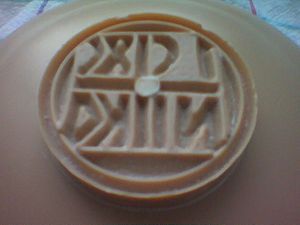Prosphora facts for kids

Russian-style prosphora seal, for five small identical loaves.
|
|
| Type | Bread |
|---|---|
| Main ingredients | Wheat flour (white), yeast, salt, water |
A prosphoron (which means "offering" in Greek) is a special small loaf of bread used in Orthodox Christian and Greek Catholic church services. The word for more than one prosphoron is prosphora. This bread is very important in the Divine Liturgy, which is a special church service where Christians remember Jesus Christ and his sacrifice.
Contents
Making Prosphora
Prosphora is made from only four simple ingredients: wheat flour, yeast, salt, and water. In some older traditions, like the Greek Orthodox Church of Jerusalem, salt is not used.
Who Bakes It?
Any church member who is a good Christian and knows how to bake can make prosphora. Often, women in a church take turns baking it. In monasteries, the leader (called an Hegumen) might ask certain monks or nuns to bake it because they live a very religious life.
Bakers often prepare themselves by going to confession and sometimes even fasting (not eating) before they start. They might use special kitchen tools just for making prosphora. Many bakers say special prayers and try to keep their minds focused on God while they bake. Usually, enough prosphora is baked at one time for several church services.
How It Looks
A prosphoron is made from two separate round pieces of dough. These are placed one on top of the other and baked together. This double loaf represents the two natures of Christ: that Jesus is both fully human and fully divine.
Before baking, each prosphoron is stamped with a special seal. This seal is called a sphragis or Panagiari. It usually has a cross on it with Greek letters that spell "IC XC NIKA" (which means "Jesus Christ conquers"). This stamp bakes into the bread and helps the priest know where to cut it later.
Different Traditions
In some traditions, like the Russian Orthodox Church, five smaller prosphora are used. This reminds people of the five loaves Jesus used to feed many people. In other traditions, like the Greek churches, one larger prosphoron is used. This reminds everyone that they all share in one "Bread" from Jesus.
Prosphora in Church Services
During the Divine Liturgy (the main church service), there's a part called the Liturgy of Preparation. Here, the priest cuts a special cube from the center of one prosphoron. This cube is called the Lamb.
This Lamb is the part of the bread that becomes the Body, Blood, Soul, and Divinity of Jesus Christ during the service. Both the priests and the church members receive this Holy Eucharist. The rest of the prosphora, which is not consecrated, is cut into smaller pieces called antidoron. This blessed bread is given out to everyone at the end of the service.
What the Pieces Mean
Prosphora can look different depending on the church tradition. Slavic churches often use five smaller prosphora with simpler stamps. Greek churches often use one larger prosphoron with a more detailed stamp. This stamp shows where the Lamb will be cut and where other small pieces will be removed.
Besides the Lamb, tiny pieces are also removed from the prosphoron to remember different groups:
- The Theotokos (which means "Mother of God," referring to the Virgin Mary)
- Angels and Saints
- People who are alive (including church leaders and the local bishop)
- People who have passed away
In Slavic traditions, a separate prosphoron might be used for each of these groups. Church members can also bring smaller prosphora with lists of living and departed people they want the priest to pray for during the service. The priest removes a small piece for each person on the list.
Panagia
One special prosphoron is called Panagia. A piece is removed from this bread to honor the Theotokos (the Virgin Mary). This prosphoron often has an icon (a religious image) of the Theotokos stamped on it.
Before cutting this prosphoron, the priest makes the Sign of the Cross over it three times. He says a prayer honoring the Theotokos. Then, he removes a large, triangular piece and places it next to the Lamb. This piece is a special reminder of the Virgin Mary's important role.
After the main service, especially in some monasteries, the remaining Panagia bread is blessed again. A monk in charge of the dining hall (called a refectorian) cuts a piece from it. This piece is then offered to the monks, who take a small bit, pass it through incense, and eat it. This is a special way to honor the Theotokos after the meal.
Artoklasia
There are also other special loaves of bread baked for blessing and sharing with church members outside of the main Divine Liturgy. These are usually called artos (meaning "loaves"). They are typically made from a single round piece of dough, not two.
These loaves might have the same stamp as prosphora, or just a simple cross or an icon of a patron saint. Usually, five loaves are made and blessed during a service called Artoklasia, which means "breaking of bread." These loaves, along with wheat, wine, and oil, are blessed and given to people during the All-Night Vigil, another church service.
Images for kids
-
Mount Nebo monastery Prosphora inscription in Greek: "Offering of Caesarios, at the time of Alexios and Theophilos, priests"
-
Greek-style prosphora seal, for one large loaf: in the center is the Lamb (symbol: IC XC NI KA Christogram), to the viewer's right is the Panagia (symbol: ΜΘ (Μήτηρ Θεοῦ)), to the left are the Nine Angelic Ranks (symbol: nine triangles), and on the top and bottom are extra Lambs for Presanctified (symbol: said Christogram). The positions of the Panagia and Nine Ranks will be reversed when the impression is made.
See also
 In Spanish: Prosforon para niños
In Spanish: Prosforon para niños





